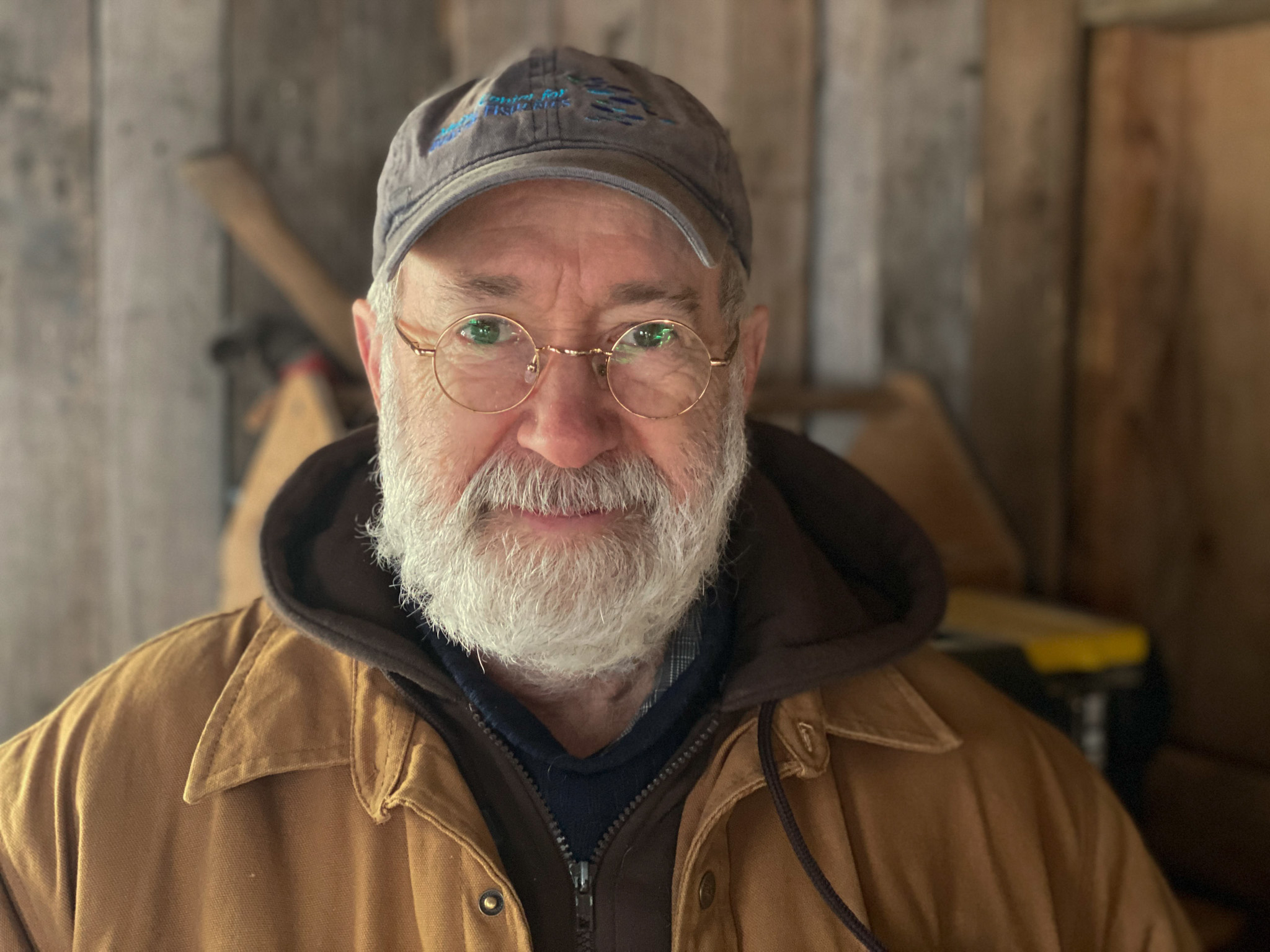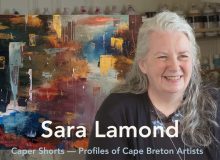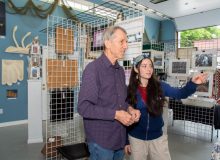Q & A with Bill Culp of the Cape Breton Partnership
When we decided to start The Scrape Magazine people said, “Go see Bill Culp.” Even if they didn’t know exactly who he was or what he did, they knew that if you’re starting anything in the arts, you need to see Bill.
So Elaine emailed him and BAM, he wanted to meet with us and to introduce us to everyone at the monthly Saturday Artisans Market, which was that weekend in St. Peters, and he wanted to introduce us to the publisher of the Reporter — “I can set up a meeting” — and there were probably a couple other ideas he had. It’s how his mind works. He believes when you put people together stuff happens.
In our other work we came across a few guys like Bill who take every opportunity to network and have made themselves the goto person in the area. He’s got a long background in the performing arts, namely being in bands and working in film in Ontario, including having his own production company that was doing well until Covid hit and steamrollered it as it did to so many things. But as you’ll read below, he’s in the thick of it all again, but this time it’s in Cape Breton in the context of working as the Creative Economy Development Officer for the Cape Breton Partnership, which sounds like he should be pretty useful to anyone in the arts in Cape Breton. And he is.
Editor’s note: We met with him at the Farmers Pantry in St. Peters.The article was both in person with email followup, which was handy because some developments jumped off in the interim that he was really excited to talk about. The text was edited for length and flow.
Organization and role
Explain what the Cape Breton Partnership is and how it is funded?
Culp: The Cape Breton Partnership is a non-profit economic development organization that aims to transform Unama’ki Cape Breton into the most creative and prosperous place on earth. And we’re funded by private investors like businesses (and organizations) that are looking to further the economic activities here on the island as well as municipalities, Indigenous communities, and there’s some provincial funding. So it’s a broad range of funders that go into supporting the organization.

How are the arts different from the ‘regular’ economy?
Culp: When you’re looking at it (the creative economy), simply through an economic development lens, the sector creates jobs, small businesses, and generates both domestic and export revenue similar to many other types of businesses. However, with arts and culture there is not only an economic impact to it, there’s also a social benefit, a quality of life component to it. And despite that fact that makes the sector unique, arts & culture can sometimes be overlooked, misunderstood, and undervalued. My aim is to change that.
What is your role in that context?
Culp: My role is the creative economy. My job includes the music industry, performing arts, motion picture and television, radio, the publishing industry, fine arts and crafts, and photography. So it’s a very broad sector and it’s an island-wide position. My main job amongst all of those is to — I call it the three C’s. I connect people, I consult with people, and I act as a catalyst in some cases. I have about 50 projects on the go right now of every shape and size.
Projects in the works
Can you give us an example?
Culp: Probably the most significant thing that I’m doing right now is I’m working with the province to bring the motion picture industry to the island which in terms of economic impact is very significant and very much includes various creative disciplines including music, writing, acting, fine arts & crafts, sound and lighting, and artists.

Do you have any specifics?
Culp: I’ve been working on the motion picture industry for the past year and a half, and I’m thrilled that my work with the Indigenous lead “Unama’ki Motion Picture Cooperative” and the Nova Scotia Department of Communities, Culture, Tourism and Heritage has made an impact. On June 28, 2024, I was thrilled to be in attendance when the provincial government announced the “Distant Location Incentive” for motion picture / TV projects in remote and rural areas of the province. As a direct and immediate result of that decision, the island has been home to several film/TV projects that are bringing in millions of dollars in local spending. For example, “Little Lorraine” has just wrapped shooting around Unama’ki Cape Breton with various scenes in CBRM including Louisbourg, Glace Bay, and also Richmond County. They hired local trainees to work on the sets from recent graduates at NSCC, employed hundreds of background extras, booked a significant number of hotel rooms for two months, spent money on food services every day for the cast and crew, hired local trucks, drivers, services, bought building supplies and wardrobe, hired musicians like Men of the Deeps, Natalie MacMaster, Donnell Leahy, hired fine arts majors to create custom signs, graphics and props, and the movie is going to be a stunning visual showcase for the island…and that’s just the start! There’s a new History Channel series shooting right now, there’s a hilarious new comedy series being shot in the fall, and a really cool artisan series about Sea Glass produced by Cape Breton Film that’ll be premiering on Bell Fibe in late 2024. (And)Bonny MacIsaac, warden of Inverness, was also involved in working with UMPCoop and myself with the province on the film incentive.
And to think prior to all this, there really hasn’t been any significant production on the island since Squanto was made for Disney back in 1994, and the days of “Pit Pony”. There were a couple of independent movie productions in the past 10 years that I should mention. They are local productions and I don’t want them to feel like I ignored them: “Werewolf” in 2016 and “Queens of the Qing Dynasty” in 2022.
There was a recent headline in both the Cape Breton Post and the Halifax Chronicle which read “THIS IS A GAME CHANGER”, and I totally agree, for both the island and the creative community here.
The Motion Picture Industry
What are those steps being taken to develop the infrastructure for the motion picture industry in Cape Breton?
Culp: The big “first step” was getting a provincial incentive to help “balance the financial equation” when filming here. For example, film crews are currently based in Halifax, and so when the island is the location for a scene, it means additional costs for hotels and per diems. Now that the province has launched the new program, the next steps involve workforce development and infrastructure development including a database of resources and locations, so I’m working with Screen Nova Scotia, NSCC, UMPCoop, ACOA, LSI, to put that in place.
I’m also working with the Smithsonian Institution on an agreement with Cape Breton University and the Center for Sound Communities which is run by Marcia Ostashewski from Cape Breton University. This deal will see Canadian artists, especially with a focus on Cape Breton artists, have their music released worldwide on the Smithsonian Folkways record label. As part of this new and exciting initiative, Marcia and the Sons of Membertou performed at the Smithsonian Folklife Festival in Washington DC from June 24 to July 1, and the SOM’s first album will be released worldwide on the prestigious Smithsonian Folkways record label later this year.

Help for Individual Artists and Artisans
Getting to individual creators, what do you think is the biggest challenge for artists and artisans getting established?
Culp: There’s a common challenge facing all artists whether it’s a musician, painter, writer, etc, regardless of where they are from. They aren’t wired to think like business people. You know, it’s a different part of the brain right? They also need to learn not to undervalue what they do. I think that’s an issue. For artists, I think they need to learn the basics of business, despite their natural inclination to focus strictly on their craft.
How might you help individual artists in the creative sector?
Culp: With individual artists, I might help them with a small business model, assist with their business plan, or point them to the [Cape Breton] Center for Craft and Design which has an entrepreneurial program, or to Duane at the Cape Breton Music Industry Cooperative.
What role does networking play in the success of artists and other businesses on Cape Breton Island?
Culp: I think meeting people, connecting with people, realizing how important having connections is something that you can’t undervalue.
Can you share some success stories of artists or projects that have benefited from your support?
Culp: I have people like Tessa McDonnell (Perch Mosaics) who went from working a day job to opening a studio and running it as a business. I’ve been working a little bit with her, just encouraging her and helping with her business without overwhelming her.
How do you address the issue of underrepresentation of certain areas, like Isle Madame, or even Richmond county in the creative economy?
Richmond County, while there are lots of artists here, there’s been a history of lack of organization. From a tourism standpoint, location-wise, we’re not as populous as CBRM (Cape Breton Regional Municipality). Geographically, we’re not as big as Inverness. We’re not as sexy as Victoria, which has the Cabot Trail. But it’s a very beautiful county and there’s a lot of great artists here.
(It’s especially true) of a place like Isle Madame, which is even further off the radar. You’ve got to know where it is and turn off, I’m a big fan of Isle Madame. Beautiful.
If you had the assignment to create more organization amongst artists and artisans in Richmond County, how would you go about it?
Culp: I’d probably do a public call for artists. Like do a Facebook post where it’s a sponsored post so it reaches a lot of people. For example: Call for artists: Are you interested in collaborating and joining forces and participating in a group that organizes Richmond artists?
In my view, when artists are organized it helps to provide a common voice for the sector. That can help with gaining the attention of the government, media, and public. Beyond that, it provides a networking tool, and can lead to exciting and fruitful collaborations amongst the artistic community. When people move forward together, it’s a “win-win” in my view.
Editor’s note: group photos provided by Bill Culp. The others were provided by the author.

You have to start some where:
We asked Bill Culp to recommend some resources and contact people if you’re in the arts.
- For Fine Arts and Crafts: Centre for Craft and Design; Inverness County Centre for the Arts
- Music: Cape Breton Music Industry Cooperative
- Writers: Cabot Trail Writer’s Festival; Breton Books; Boularderie Island Press
- Film: Unama’ki Motion Picture Cooperative; Cape Breton Film, Telile TV
- Performing Arts: Highland Arts Theatre; Savoy Theatre; Strathspey Place; Boardmore Theatre; Port Hawkesbury Civic Centre; Louisbourg Playhouse; La Picasse (Isle Madame)

Author details
Archie Nadon, writer and photographer, left Ontario in 76 dreaming of living by the sea. In 2021 it finally happened.







